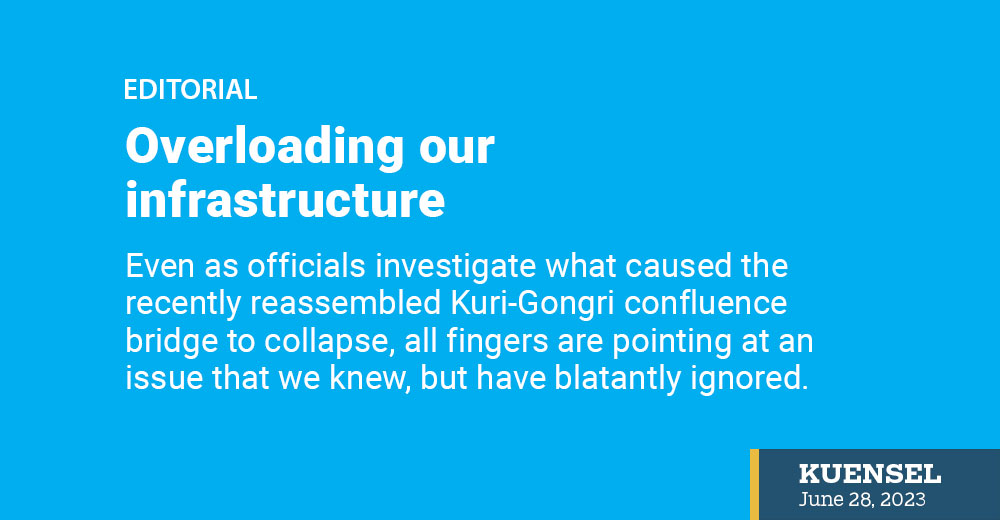Even as officials investigate what caused the recently reassembled Kuri-Gongri confluence bridge to collapse, all fingers are pointing at an issue that we knew, but have blatantly ignored. Although reports were not made public, the same bridge collapsed in May because the truck crossing was carrying 10 metric tonnes (MT) over the carrying capacity of the bridge, 24MT.
Officials are suspecting overloading as the bridge collapsed when a 10-wheeler truck carrying bricks was crossing it. Overloading, from records, had been the main cause of bridges collapsing, incurring huge loss to the government and robbing people of crucial infrastructure.
Our memories are short, but when we look back, we have seen bridges collapse because of overloading. In January, 2019, the bridge over Namchu in Samtse with a carrying capacity of eight MT collapsed when two trucks carrying 12MT each were crossing it. Four months later, Kuchidiana bridge collapsed when a truck carrying 38MT load overwhelmed the bridge with 18MT capacity. In February 2021, the Wangchhu bridge collapsed while conducting a load carrying capacity even before it opened to traffic.
As a country situated in a fragile terrian, our infrastructure are prone to damages from natural elements. Every year we see bridges washed away by flash floods or landslides. There is not much we can do in facing the wrath of the nature, but overloading is manmade. We could easily prevent damages to bridges from overloading.
Trucking or transportation is a lucrative business in landlocked Bhutan. Truckers try to make the most, and there are tricks up the sleeves to make some extra income by carrying a few extra loads. In the meantime, not all our bridges are built keeping in mind the heavier trucks carrying heavier loads. This is not good for our roads or bridges that are taking a toll, evident from the recent incidents.
Many of our bridges are designed just to connect, without the hindsight of carrying capacity. Even if there is a load carrying capacity notice glaring at the truckers, many cannot read or follow. This is where monitoring comes in. Following the May 23 incident, the minister for infrastructure and transport said the carrying capacity would be increased to 35MT. It was increased to 40, according to officials. It is, however, not known how much load the 10-wheeler was carrying.
The Gyalpoizhing-Nganglam has become a busy road because it cuts distance significantly. The bigger the carrying capacity of trucks, the greater the damage on the roads and bridges. Have we monitored the loads trucks are carrying? Are there weigh bridges? Even if there is one, truck drivers know how to cheat if the truck belongs to a malik.
Some are even questioning the quality of bridges we build after assembling parts from old bridges. Even without engineering knowledge we can surmise that old materials will not give the required strength. A bridge under construction over Maokhola in Sarpang collapsed because they used panels from old bridges.
The call is for accountability. If the bridge was not strong enough and the truck carried the right size of load, the driver and the owner should be compensated. Both the driver and his wife are suspected to have died in the accident. Who will bear the accountability of two lives lost?
Our policymakers and elected representatives always talk about bridging the gap between the (government) and the people. We could start with strengthening the bridges first.


